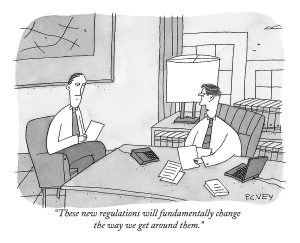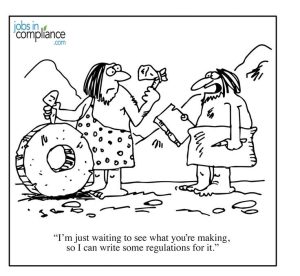Before we deep dive into the complex realm of regulation, we should start with why we need it at all. Regulation is a process of putting balances in place to reconcile different needs and interests. For example, food on the market needs to be proven safe, while still leaving room for novelty and a diversity of tastes and preferences.
Regulators try to assess and accommodate these needs, considering potential risks, how likely those hazards are to materialise and the implications if they do. They also consider the consequences of putting regulations in place at all – for instance on the economy. In this context, regulators must assess the pros and cons of intervention both in the domestic setting in terms of our international trading relationships.

Navigating the regulatory landscape
Agriculture has a particularly complex patchwork of regulatory concerns. Whether you’re farming or developing technologies for farmers, there is no one-agricultural-regulator-fits-all solution. Instead, we must take account of many different regulatory bodies, such as those for food safety, environmental protection, health and safety at work, and sometimes less obviously related domains such as aviation regulations affecting drone technology.
Since Brexit, and because of different regulatory frameworks in the devolved nations, the regulatory landscape has become more onerous in the UK. Our home market is generally considered too small for products to be viably developed solely for domestic purposes, especially if there is a large regulatory cost. The result is that companies are effectively subject to a duplicate regulatory system. For instance, active ingredients to protect crops in our climate and agricultural systems must be assessed against both the various UK regulatory system as well as the EU’s.
Enabling innovation the ‘right’ way
One of the most difficult balancing acts is ensuring human and environmental safety while also leaving scope for innovation. Innovators are always on the lookout for new ways of doing things, and hence are always ahead of regulators. This creates (to borrow from former US defence secretary Donald Rumsfeld) both “known unknowns” and “unknown unknowns”. Regulators can only address the risks they are aware of, but if they heavy-handedly apply yesterday’s regulatory frameworks they may stifle innovation in tomorrow’s technologies.
Yet, while too much regulation creates cost and risks killing innovation, so could too little regulation. A lack of clarity about where the ‘regulatory goal posts” are not only creates gaps where hazards for consumers may emerge, but can also deter investors and innovators concerned that future regulation will undermine technology advances already made. It is, therefore, important for the UK to get the regulatory environment right to persuade investors and innovative companies to choose this country as a place to commercialise their ideas. Not doing so would be a great loss to the UK, which is so good at the ‘blue-sky’ research phase of innovation.
One way to achieve this is developing frameworks to enable responsible innovation. We can learn from other sectors – such as healthcare – which have different regulatory hurdles for different technology readiness levels and depending on the ultimate use of an innovation. For instance, the MHRA requires more stringent oversight of high-risk technologies and applications, such as greater regulatory hurdles for medical devices to be used in-vivo (e.g. an implanted stent) than for in-home personal use (e.g. a blood pressure monitor). Another valuable component to stimulate innovation, is to allow regulators to consider the potential benefits of a new technology or product, in addition to the risks.
A clear vision nurtures responsible innovation
To trade off many demands, risks and benefits, regulators work best when they have a clear sense of direction. Here the UK is at a disadvantage, lacking a national food and agricultural strategy to provide guidance. Regulation is led by a unified and established purpose – as a nation, how do we want to balance food security against a focus on sustainability and environmental challenges? How do interruptions (such as the war in Ukraine) affect our balance of priorities? A clear roadmap could indicate the limits of innovation while also providing the freedom to devise novel technologies or products to meet changing needs.
Given the patchwork of regulators affecting AgriTech, the sector would also benefit from a central point-of-call for both convening various points of view and for providing sign-posting to resources needed. The AgriTech centres, and sessions like CHAP’s Advisory Group meeting, go some way to achieving this but fall short of being the full solution.

Tackling the challenges ahead
The Covid-19 pandemic demonstrated how, when the risks change and a threat is felt with sufficient urgency, a highly regulated process for innovation can change very quickly. When it comes to agriculture and food production, there are equally serious threats on the horizon in the shape of climate change, biodiversity loss and food security. Humans are hardwired to focus on the things we experience on a day-to-day basis and discount far off concerns, which means threat of these changes – and the implications for our regulatory context – hasn’t hit home properly. If we leave improving AgriTech regulation until the full effects of climate change, biodiversity loss and its effect on food security are felt, we might feel differently about the balance of priorities we are willing to support.
Regulators, and the Government they work for, are the country’s risk-managers in chief. There is currently a golden opportunity to set up the regulatory landscape in both food and agriculture to unleash the nation’s innovation abilities before of the impact of these seemingly still-remote factors is felt. A regulatory environment which allows safe and responsible innovation, considerate of both trading partners and environmental concerns could be transformative for the UK.
Hannah Senior NSch is a champion of AgriTech entrepreneurship. She runs PBS International Ltd, a CHAP member, working with plant breeders and seed producers to design and manufacture solutions for pollination control.
If you have any questions about becoming a member of CHAP, or would like to reach out to the CHAP team to discuss other project opportunities, please send us an email using the enquiries form at the bottom of our homepage.
Please note, the opinions expressed in this article are the author’s own and do not necessarily reflect the views or opinions of CHAP.














